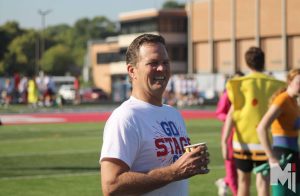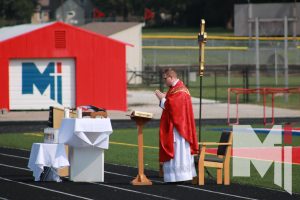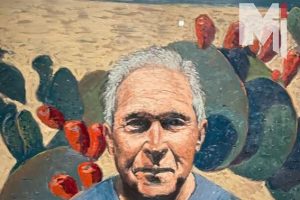On Your Mark, Get Set, Throw: Athletes working beyond the track.
Coach Ryan “Gravy Boat” Graves readies the shotput, a familiar motion for a coach who just three years ago was throwing the shotput for Avila University.
April 26, 2023
The black, latex-bound rubber is heated by the collective swarm of athletic variety, and the practice has begun. Runners, jumpers and throwers alike join together to partake in a dynamic-stretching warmup, proctored by head coach Steve Koesterer. Together, they prepare for the following two hours of rigor, celebrating the grandfather of sports, track and field.
“Warmup is essential for the flow of the practice,” Koesterer said. “Getting prepared with your stretching routine but also doing your mental activities.”
Once primed, the dozens of athletes splinter toward their respective events. While sprinters and distance runners collect around the track, the backbone of the team finds themselves up the hill, tucked away upon the football team’s practice field or filed in line within the turf, patiently waiting for their turn to polish their skills as throwers and jumpers.
“Our throwers are really strong on the girls’ side with Ali Olson and Stella Cahalan,” Koesterer said. “Arasto Sadeghi and Finn Cusick are doing great as well.”
Olson recently cemented herself in school history with a 39-foot 5-inch shotput throw, the second furthest recorded in team history, breaking ground that had been left untouched for the past 37 years.
“Daegan Jensen, Jack Elder, Ali Olson and Stella Cahalan are all hard-working athletes that have bought into the process for three years,” throwing coach Ryan Graves said.
The community of throwers takes up unique workouts relative to the rest of the team, focusing on upper body strength in conjunction with pin-point full-body movements. With steep regional competition, striving for success means going above and beyond to put in the work.
“Do all the little things right and show up every day,” said Graves, who is fondly referred to by the team as “Gravy Boat.”
The concurrence of upper and lower-classmen within the track team implements a posture of age-breaching peership, while simultaneously providing natural role models to the less experienced. With throwing events such as shot put, discus and javelin, a technical focus is necessary for success.
It is athletes like Cusick who will continue to demonstrate ability and dedication to his predecessors in the following years, continuing the tradition of excellence that has been passed down to him through the likes of athletes Jack Elder and Daegan Jensen.
“Jack Elder is a universal guy, he throws and runs,” Koesterer said.
Versatility is the cornerstone of track and field. By reducing limitations, athletic experimentation is able to take place, fostering an environment for unexpected flourishing that inspires others.
“Prior to this year, I wasn’t a runner at all.” Elder said, “I’m working my joints up to runner levels while splitting my practices between throws and runs.”
Splitting time between coaches and activities, Elder’s practice weeks consist of workload management equivalent to two athletes.
“Show up and do work.” Koesterer said, “You have to be dedicated.”
Track and field is reliant on individual motivation through self-competition. Athletes constantly compete against their own PRs, or personal records, making the sport one that demands discipline and dedication, qualities that radiate to onlooking coaches.
With twenty-five years of experience, Koesterer maintains a tradition of success through the team, airing ample focus on each of the many sectors that make it up. The team looks forward to the upcoming state competitions with many athletes, including PJ McCallop and LJ Lynch anticipating memorable performances.
“It’s about getting yourself in a championship frame of mind,” Koesterer said.







